- Home |
- About |
- Contact Us |
- Privacy |
- Newsletter |
- Shop |
- Donate
Adding Improper Fractions

Welcome to our Adding Improper Fractions support page.
On this page we have some worked examples and a range of worksheets to help you
to learn and practice adding two improper fractions together.
Our sheets cover adding with both like and unlike denominators.
Adding Fractions Calculator
If you just want a calculator to do the hard work for you, then try our Adding Fractions Calculator.
The calculator will add any two fractions (proper or improper).
The great thing is that it will also show you all the working out - job done!
If you would rather learn how to do this for yourself, then ignore this part and keep reading.
Adding Improper Fractions Support
Students are taught about adding and subtracting fractions with like denominators at the 3rd grade level, and with unlike denominators around 5th grade.
Adding improper fractions is exactly the same as adding two proper fractions - there is no real difference, other than the value of each of the fractions is over 1 whole
Here are 2 easy steps to help you add two fractions together.
Step 1: Convert the fractions to the same denominator.
If the fractions already have the same denominator, you do not need to do anything!
Step 2: Add the two numerators together (and keep the denominator the same) to get the answer.
You should now have the answer to your fraction sum!
You may also need to simplify the fraction at the end.
See below for a step-by-step breakdown of how to add fractions.
Step 1: Convert the fractions to the same denominator.
If the fractions already have the same denominator, skip the rest of this part.
If the fractions have different denominators, keep reading!
We can only add fractions together if they have the same denominator.
It is a bit like when you are adding inches and centimetres together - you need to convert both measures to the same units - either centimetres or inches!
There are two different possibilities for the this step:
Step 1a) If one of the denominators is a multiple of the other denominator.
If this is the case, you just need to multiply the numerator and denominator of the fraction with the lower denominator so that the two denominators are the same.
Step 1b) If one of the denominators is not a multiple of the other denominator.
The easiest and simplest way to convert the two fractions to equivalent fractions with the same denominators is to multiply the numerator and denominator of each fraction by the other fraction's denominator.
Step 2: Add the two numerators together
Once the two fractions have the same denominator, we can add the numerators together.
This will give us the answer we are looking for.
Have a look at the examples below to see how it all works!
Adding Improper Fractions - Examples
Example 1) Work out the fraction sum below giving your answer as a mixed number. \[ {14 \over 9} + {16 \over 9} \]
Step 1)
You will notice that the two denominators are identical so we can go straight on to Step 2).
Step 2)
We just need to add the two numerators together, and simplify the fraction at the end.
\[ {14 \over 9} + {16 \over 9} = {14 + 16 \over 9} = {30 \over 9}\]
Step 3)
First we need to simplify the fraction by dividing the numerator and denominator by 3.
\[ {30 \over 9} = {30 ÷ 3 \over 9 ÷ 3} = {10 \over 3}\]
Next we need to convert this improper fraction to a mixed number.
\[{10 \over 3} \; = \; 3 {1 \over 3} \]
Final answer: \[ {14 \over 9} + {16 \over 9} \; = \; 3 {1 \over 3}\]
Example 2) Work out \[ {13 \over 5} + {22 \over 15} \]
Step 1)
You will notice that the second denominator (15) is a multiple of the first denominator (5) so we need to follow Step 1a)
So we need to multiply the numerator and denominator of the first fraction by 3.
\[ {13 \over 5} = {13 \times 3 \over 5 \times 3} = {39 \over 15} \]
This gives us: \[ {13 \over 5} + {22 \over 15} = {39 \over 15} + {22 \over 15} \]
Step 2)
Now the denominators are equal, all we need to do now is to add the numerators together.
\[ {39 \over 15} + {22 \over 15} = {39 + 22 \over 15} = {61 \over 15}\]
Step 3)
This fraction is already in simplest form.
Final answer: \[ {13 \over 5} + {22 \over 15} = {61 \over 15} \; or \; 4 {1 \over 15}\]
Example 3) Work out this fraction sum, giving your answer as a mixed number: \[ {11 \over 7} + {9 \over 4} \]
Step 1)
The denominator of the first fraction is 7. The denominator of the second fraction is 4. These numbers are not multiples of one another.
We need to use Step 1b)
So we multiply the numerator and denominator of the first fraction by the second fraction's denominator (4).
This gives us: \[ {11 \over 7} = {11 \times 4 \over 7 \times 4} = {44 \over 28} \]
Next we multiply the second fraction's numerator and denominator by the first fraction's denominator (7).
This gives us: \[ {9 \over 4} = {9 \times 7 \over 4 \times 7 = {63 \over 28} \]
So we now have: \[ {11 \over 7} + {9 \over 4} = {44 \over 28} + {63 \over 28} \]
Step 2)
Add the numerators together. \[ {44 \over 28} + {63 \over 28} = {44 + 63 \over 28} = {107 \over 28} \]
Step 3)
This fraction is already in simplest form, so we need to convert it to a mixed number.
\[{107 \over 28} \; = \; 3{23 \over 28} \]
Final answer: \[ {11 \over 7} + {9 \over 4} \; = \; 3{23 \over 28}\]
How do you add fractions - the algebra...
For those of you who like to see things in Algebra...this is what it looks like
To add 2 fractions: \[{a \over b} + {c \over d} \]
First we convert the two fractions to the same denominator by multiplying the numerator and denominator of the first fraction by d, and the numerator and denominator of the second fraction by b.
This gives us : \[{a \over b} + {c \over d} = {a \times d \over b \times d} \; + \; {c \times b \over d \times b}\]
Since b x d is the same as d x b, we now have two fractions that are equivalent to the fractions we started with, and have the same denominator!
The last step is to add up the numerators, this gives us: \[{ad \over bd} \; + \; {cb \over bd} \; = \; {ad + bc \over bd}\]
Adding Improper Fractions Worksheets
We have a range of worksheets available for you to practice the skill of adding improper fractions.
The sheets start off easier and gradually get harder and harder.
The breakdown of the skills taught on the sheets is written above each sheet so you can see the skills required.
Adding Improper Fractions with like denominators Worksheets
Sheet 1 - adding improper fractions with the same denominator - no simplification necessary
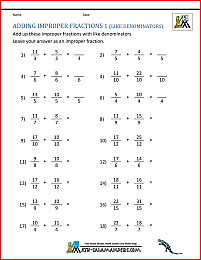
Sheet 2 - as for sheet 1, but fractions need simplifying.

Adding Improper Fractions Worksheets
Sheet 1 - adding improper fractions with one denominator being a multiple of the other, e.g. 6/5 + 17/15.
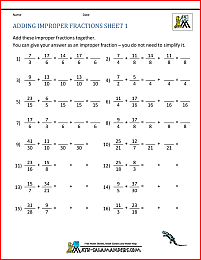
Sheet 2 - adding two improper fractions with different denominators, no simplifying needed. Supported.

Sheet 3 - as for sheet 2) but with a more efficient way of calculating. Supported. No simplifying needed.

Sheet 4 - as for sheet 3) but fractions need simplifying.

Sheet 5 - as for sheet 4) but fractions need writing both as improper fractions and mixed fractions.

As for Sheet 5) but fractions are slightly harder.
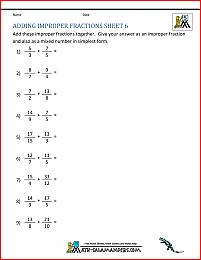
More Recommended Math Resources
Take a look at some more of our resources similar to these.
Adding and Subtracting Fractions
Here you will find a selection of Fraction worksheets designed to help your child understand and practice how to add and subtract 2 fractions.
Before your child tackles adding and subtracting fractions, they should be confident with equivalent fractions.
Using these sheets will help your child to:
- apply their understanding of equivalent fractions;
- add 2 fractions with different denominators;
- subtract 2 fractions with different denominators.
Learning Fractions Math Help Page
Here you will find the Math Salamanders free online Math help pages about Fractions.
There is a wide range of help pages including help with:
- fraction definitions;
- equivalent fractions;
- converting improper fractions;
- how to add and subtract fractions;
- how to convert fractions to decimals and percentages;
- how to simplify fractions.
Free Fraction Calculator
Here you will find the Math Salamanders Free Fraction Calculator.
This calculator will enable you to:
- add, subtract, multiply and divide fractions
- convert fractions to simplest form
- convert improper fractions to mixed fractions
- convert fractions to decimals and percentages
- convert decimals and percentages to fractions.
There are also support sheets to help you learn these fraction skills further down the page.
How to Print or Save these sheets 🖶
Need help with printing or saving?
Follow these 3 steps to get your worksheets printed perfectly!
How to Print or Save these sheets 🖶
Need help with printing or saving?
Follow these 3 steps to get your worksheets printed perfectly!
Subscribe to Math Salamanders News
Sign up for our newsletter and get free math support delivered to your inbox each month. Free seasonal math grab pack included.
Return to Free Math Help Online
Return from Adding Improper Fractions Support to Math Salamanders Homepage
Math-Salamanders.com
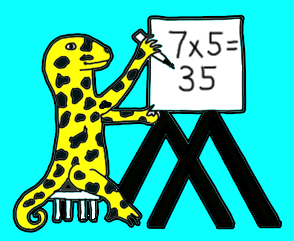
The Math Salamanders hope you enjoy using these free printable Math worksheets and all our other Math games and resources.
We welcome any comments about our site or worksheets on the Facebook comments box at the bottom of every page.

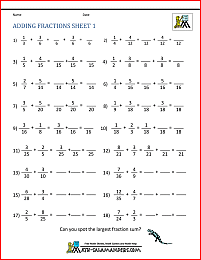

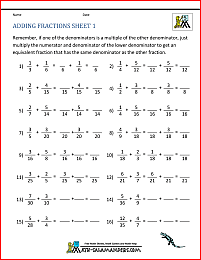
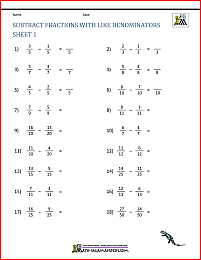
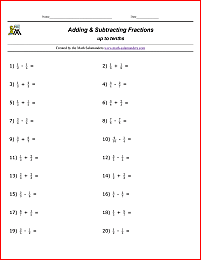
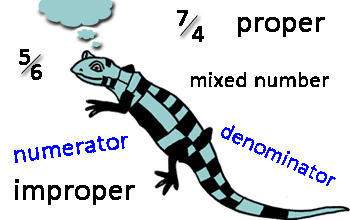


New! Comments
Have your say about the Math resources on this page! Leave me a comment in the box below.